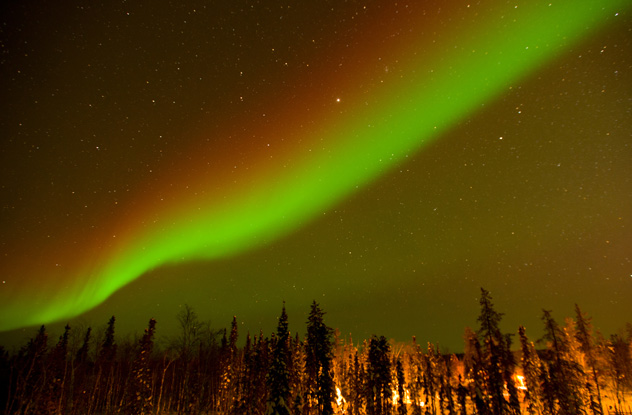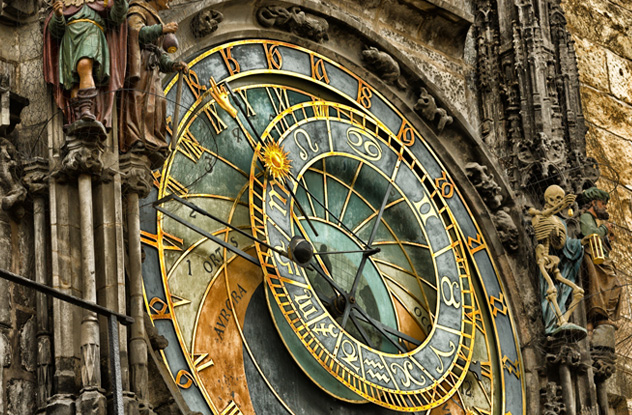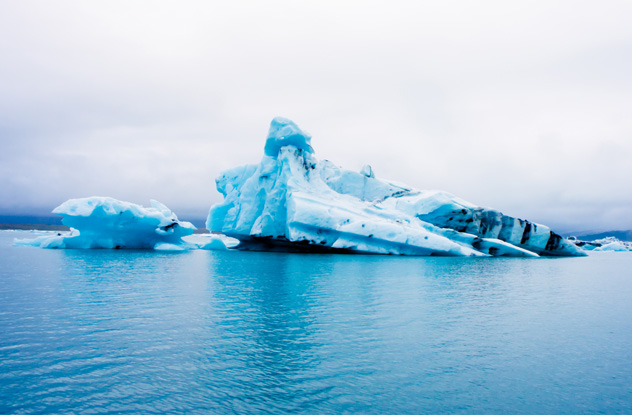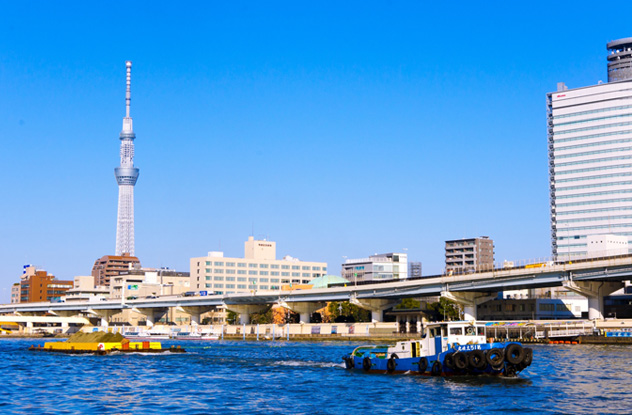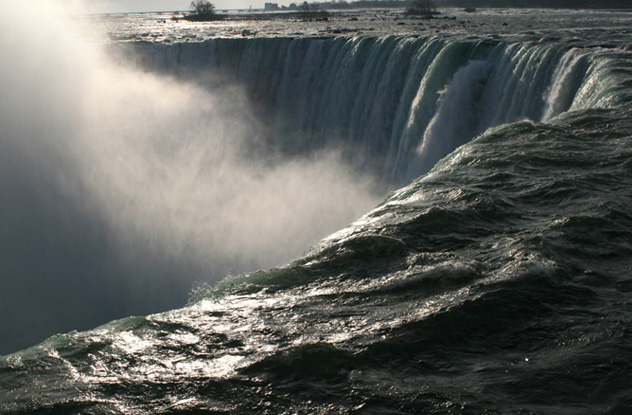But what if we told you that you could do all of that? Right now, this very second? While the miracle of teleportation is still some years away, the Internet offers the next best thing: live webcams. Just one click of a button can instantly take you almost anywhere you can imagine. So why not visit . . .
10International Space Station
One of humanity’s greatest achievements to date is sending objects into Earth’s orbit and beyond. Yuri Gagarin became the first person to go to space in 1961. Many others have followed in his footsteps since. On top of that, we’ve launched an increasing number of man-made objects up there, including no fewer than 2,500 satellites. By far the largest artificial object orbiting our planet is the International Space Station (ISS). Launched on November 20, 1998, the ISS is a true testament to what we can achieve when we bring together technological and scientific expertise from across the globe. The ISS functions mainly as a microgravity science lab. It can be manned by up to six people at any given time. Only a few chosen ones will ever get to step aboard the ISS. These lucky few will get to see the planet in all its glory from up above. The rest of us? We’ll just have to make do with the high-definition streaming webcams, won’t we? One of these is dedicated exclusively to broadcasting superb, high-quality views of Earth as seen from the ISS. Another one lets you listen in on the crew’s chatter and even see them working when they’re on duty. Whichever one you pick, you won’t be disappointed. It’s quite likely as close as can ever get to living among the astronauts. Watch the webcams here.
9Coral Reefs
Coral reefs are nothing short of spectacular. These “rain forests of the ocean” house and feed as many as 25 percent of all ocean species, sustaining an impressive biodiversity of life. Coral reefs are typically found in tropical and subtropical waters. The largest and most famous of them—the Great Barrier Reef—has taken an astonishing 20,000 years to take its current shape. But that’s not why most of us find the reefs so fascinating, is it? No, we simply like their pretty colors and the fact that the protagonist of Finding Nemo lives there. We like them so much, in fact, that the coral reefs generate almost $10 billion in tourism and recreation value each year. The flip side is that tourists are contributing to a potentially irreversible destruction of the reefs. That’s what happens when an excited snorkeler snags a piece of the coral to take home as a souvenir. A single second is all it takes to ruin something that’s taken millennia to form. So if you ever do visit the reefs, remember to leave them intact for future generations. Or you could go for a bit of virtual tourism and simply check out the many high-definition reef cams online. Watch the webcams here.
8Antarctica
Antarctica is so remote that only the most dedicated among us will ever travel to the interior of this icy continent. There are permanent research bases in Antarctica, but they’re manned by as few as 1,100 people during the harsh winter months, rising to about 4,400 in the summer. While humans haven’t established a significant presence in Antarctica, millions of penguins call it home. Just one species of these cute creatures—Adelie penguins—number around 3.8 million breeding pairs. Everyone loves penguins, but most people will only get to see them outside their natural habitats—in zoos and sea parks around the world. At least that used to be the case. Now, thanks to a partnership between the University of Alabama at Birmingham and a few science foundations, you can watch the Antarctic penguins online from the comfort of your home. The penguin cam itself is only operational during the warmer Antarctic months, from October to end of February. The good news is that the webcam of the Palmer Station—the only US research facility on the Antarctic Peninsula—is online at all times. And it’s just one of the Antarctic exploration cams available. So you are free to observe either the penguins or US researchers braving subzero temperatures. Watch the webcams here.
7African Safari
Those who prefer a warmer climate are often fascinated by the idea of getting close to the wild animals of Africa. African safaris tend to be at the top of “things to do before you die” lists. The continent teems with species not found elsewhere on Earth. An African safari is easily the trip of a lifetime for many people. Nothing will ever compare to the feeling of actually being there and seeing the elephants, giraffes, and cheetahs in their natural environment. If you’re lucky enough to have the time, money, and energy to take a safari trip, we’d be foolish to discourage you. But what if you don’t have such an opportunity? Don’t fret, for there’s a South African company that specializes in bringing you as close as possible to these wild animals using the magic of streaming video. Africam has put up cameras in some of the busiest wildlife spots around Africa. These cameras stream live video and sound 24 hours a day. Thanks to night vision, these feeds aren’t entirely useless—and are perhaps even more exciting—after darkness falls. Watch the webcams here.
6The Northern Lights
Another bucket list favorite is the aurora borealis, also known as the northern lights. Northern lights are formed by charged particles colliding with the atmosphere and bursting into different colors. These range from bright green to deep blue to ruby red, depending on the altitude. The different colors mingle and paint curious patterns in the night sky—a sort of nighttime rainbow. The aurora is one of the most incredible and mesmerizing sights around. To see it, you usually need to travel to regions near the Arctic, like Canada, Alaska, Iceland, or northern parts of Scandinavia. The best time to catch the northern lights is from September to April. Many tour operators offer packages specifically for those chasing this elusive occurrence. Not up for traveling? Then you don’t have to. Thanks to modern technology, you can not only predict when and where the northern lights will occur but witness this phenomenon without having to tear yourself away from the computer. Watch the webcams here.
5Prague City Center
The capital of the Czech Republic is one of the oldest and most beautiful places in Europe. Every year, no fewer than four million tourists flock to Prague, making it the 22nd-most-visited city in the world. The center of Prague is filled to the brim with noteworthy old architecture, from the 14th-century Charles Bridge to the Prague Castle—the biggest medieval castle in Europe. The quaint Old Town district offers many unique sights of its own. It’s also the location of the oldest functioning astronomical clock in the world, hanging on the wall of the Old Town City Hall. Every hour, two square windows above the clock face open, and a procession of figurines makes its way through, popping in and out of the open windows. This brief show is called “The Walk of the Apostles” and draws crowds of gawking onlookers. All of these sights and many others are available to anyone with access to the Internet. The camera across the astronomical clock even lets you control the viewing angle and zoom in on the action. So why not catch the apostles doing their thing? Watch the webcams here.
4Jokulsarlon Glacial Lake
Jokulsarlon is as tranquil as it is tough to pronounce. Jokulsarlon literally translates as “glacial river lagoon,” and it’s pretty much exactly that: a charming glacial lake located close to Europe’s largest glacier—Vatnajokull, in Iceland. It is one of Iceland’s must-sees, and numerous operators offer boating tours to the lagoon. As many of these operators won’t stop reminding you, the lake was also used as a filming location for multiple Hollywood movies, including Batman Begins and Die Another Day. While it’s truly an awe-inspiring natural wonder, Jokulsarlon’s presence is somewhat bittersweet. Its very existence is the result—and continued evidence—of global climate change. The lake formed in mid-1930s, when the tongue-twisting Breidamerkurjokull glacier started to melt and lose chunks of ice. Since then, the retreating glacier supplied more and more ice to the lagoon. As the glacier disappears, Jokulsarlon grows. A lone webcam bears witness to this gradual transformation. So tune in and watch live streaming video that tells the tale of disappearing glaciers and thriving glacial lagoons. Watch the webcam here.
3Tokyo Skyline & Skytree Tower
Tokyo is a dazzling, eclectic clash of hyper-modern architecture, high-speed lifestyle, and traditional Japanese culture. It’s the most populated metropolis in the world with 38 million residents. Each year, millions of foreigners visit Tokyo to absorb its unique fusion of the old and the new. The city’s skyline is dotted with imposing skyscrapers, including the tallest structures in all of Japan. For decades, the Japanese height record belonged to the 333-meter (1,100 ft) Tokyo Tower. As of 2012, that is no longer the case. The recently completed Tokyo Skytree now absolutely dwarfs the Tokyo Tower, standing a staggering 634 meters (2,080 ft) tall. Tokyo Skytree is the world’s highest self-supporting tower and second-tallest building, losing out only to Burj Khalifa in Dubai. Skytree’s primary function is as a communications tower, but it doubles as an eerie, blinking Eye of Sauron at night, looming over the city. Think we’re making that up? Then wait until it gets dark in Japan and see the Tokyo skyline and the Skytree Tower for yourself from a conveniently placed webcam. (On some nights, visibility may be limited, but it’s worth coming back for.) Watch the webcam here.
2Niagara Falls
Three separate waterfalls on the Canada-US border form the Voltron of waterfalls known as Niagara Falls. Two of these—American Falls and Bridal Veil Falls—are on the US side. The one in Canada is called Horseshoe Falls but is sometimes referred to as Canadian Falls to make sure there’s little doubt as to its location. Niagara Falls was once the go-to destination for newlyweds, as portrayed in the Niagara movie starring Marilyn Monroe. It is still enormously popular with tourists: About 12 million people come here every year. Not only is it a prominent tourist attraction, but Niagara Falls also serves a more practical purpose: supplying a significant amount of hydroelectric power to US and Canadian homes. A whopping 3,160 tons of water run over Niagara falls every second—90 percent of that over Horseshoe Falls alone. If you wonder what that amount of sheer force looks like, head on over to the three webcams covering the waterfalls and the Niagara River itself, and see it with your own eyes. Watch the webcams here.
1Mount Everest
Mount Everest is the highest mountain on the planet and a temporary home to hundreds of brave climbers each year. Since it was first conquered in 1953, an estimated 4,000 people have reached the mountain’s 8.8-kilometer (5.5 mi) summit. Over recent years, the constant stream of ambitious hopefuls has become a bit of a problem. Some days, there are legitimate traffic jams as dozens of people await their turn to continue the climb. On top of that, the ever-increasing crowds leave behind trash that requires separate expeditions to clean up. As one experienced climber described it, “It isn’t a wilderness experience—it’s a McDonald’s experience.” With the once-pristine peak setting tourist saturation records, there’s some debate as to what should be done about it. Some suggest limiting the number of climbing permits, while others have proposed installing special ropes to make the climb easier and faster for amateurs. In the meantime, the rest of us can enjoy the view from a webcam aimed directly at the mountain’s summit. It’s operational from 6:30 AM to 5:30 PM Nepal Standard time. Watch the webcam here. Daniel’s humor blog may not be particularly exotic, but you can certainly visit it from your couch.




